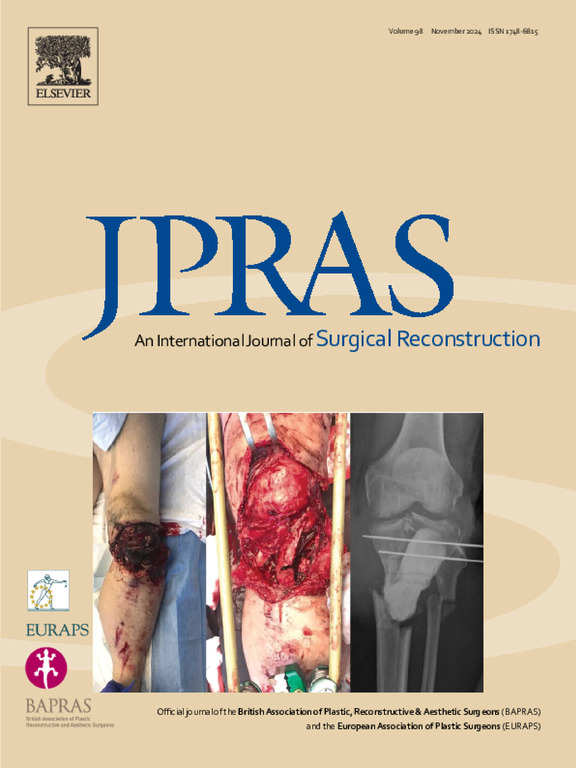Dorsal roof flap rhinoplasty: Updated results and a new classification of nasal dorsal deformity
IF 2
3区 医学
Q2 SURGERY
Journal of Plastic Reconstructive and Aesthetic Surgery
Pub Date : 2024-09-18
DOI:10.1016/j.bjps.2024.09.047
引用次数: 0
Abstract
Background
The dorsal roof flap (DRF) technique was developed as a modification of the retractable roof method, which is a variant of dorsal preservation (DP).
Objective
The paper aims to present new results of the DRF technique and dorsal deformity analysis created for the technique.
Methods
A total of 57 primary rhinoplasty patients treated with DRF technique between 2022–2023 years were included in the study. A dorsal deformity classification based on the anticipated amount of dorsal reduction, nasal bone shape, and hump content was used. According to the classification, the noses were categorized into 3 types. All data were obtained from patient records, computed tomography views, and pre-and postoperative photographs. Aesthetic and functional results were assessed pre-and postoperatively using a visual analog scale (VAS) (0–10, 0 points means very poor).
Results
The mean follow-up period was 10.1 ± 3.9 months. 23 cases were type 1, 14 were type 2, and 20 were type 3. The anticipated amount of dorsal reduction in type 1 was 2–4 mm, 5–7 mm in type 2, and 8–10 mm in type 3 deformity. Of the total, 27 cases had a V-shaped nasal bone and 30 had an S-shaped. The hump composition was cartilaginous in 13 cases and bone and cartilage in 44 cases. Pre- and postoperative aesthetic and functional VAS scores were significantly different (p ≤ 0.001). No complications and therefore no revisions were observed during the follow-up period.
Conclusion
It is a versatile method to reshape the nasal dorsum and minimize the revisions associated with dorsal preservation when used in appropriate cases.
鼻背顶皮瓣鼻整形术:鼻背畸形的最新结果和新分类。
背景:背顶皮瓣(DRF)技术是在可伸缩背顶法的基础上发展起来的,而可伸缩背顶法是背侧保留(DP)的一种变体:本文旨在介绍 DRF 技术的新结果以及针对该技术的鼻背畸形分析:研究对象包括 2022-2023 年间采用 DRF 技术治疗的 57 例初次鼻整形患者。研究根据预期的鼻背缩小量、鼻骨形状和驼峰内容进行了鼻背畸形分类。根据该分类法,鼻部被分为三种类型。所有数据均来自患者记录、计算机断层扫描视图和术前术后照片。使用视觉模拟量表(VAS)(0-10 分,0 分表示非常差)对术前和术后的美学和功能效果进行评估:平均随访时间为 10.1 ± 3.9 个月。23 例为 1 型,14 例为 2 型,20 例为 3 型。1型畸形的预期背缩量为2-4毫米,2型为5-7毫米,3型为8-10毫米。在所有病例中,27 例为 V 形鼻骨,30 例为 S 形鼻骨。驼峰成分中,13 例为软骨,44 例为骨和软骨。术前和术后的美学和功能 VAS 评分有显著差异(P ≤ 0.001)。随访期间未发现并发症,因此也未发现翻修:结论:这是一种重塑鼻背的多功能方法,在合适的病例中使用时,可将与保留鼻背相关的翻修率降到最低。
本文章由计算机程序翻译,如有差异,请以英文原文为准。
求助全文
约1分钟内获得全文
求助全文
来源期刊
CiteScore
3.10
自引率
11.10%
发文量
578
审稿时长
3.5 months
期刊介绍:
JPRAS An International Journal of Surgical Reconstruction is one of the world''s leading international journals, covering all the reconstructive and aesthetic aspects of plastic surgery.
The journal presents the latest surgical procedures with audit and outcome studies of new and established techniques in plastic surgery including: cleft lip and palate and other heads and neck surgery, hand surgery, lower limb trauma, burns, skin cancer, breast surgery and aesthetic surgery.

 求助内容:
求助内容: 应助结果提醒方式:
应助结果提醒方式:


